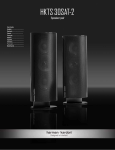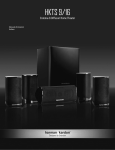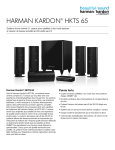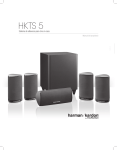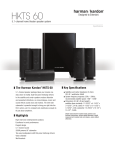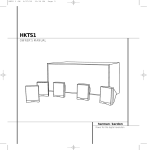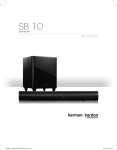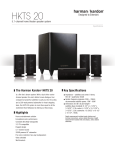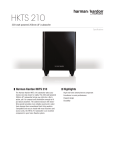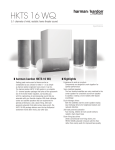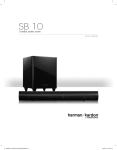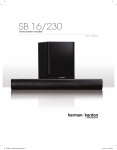Download Harman Kardon HKTS 200 Owner's Manual
Transcript
HKTS 210 SUB/HKTS 200 SUB Subwoofer Owner’s Manual HKTS 210 SUB/HKTS 200 SUB Introduction Introduction, Included Items and Subwoofer Rear-Panel Controls Subwoofer Rear-Panel Controls Thank you for choosing this Harman Kardon product! Your new Harman Kardon 200-watt powered subwoofer incorporates an 8" (200mm) down-firing cone transducer and a built-in, high-performance, 200-watt amplifier that delivers the powerful, dynamic and accurate low-frequency performance that makes your film soundtracks and music come alive. And with line-level and LFE inputs, phase control and automatic turn-on/turn-off, the HKTS 210 SUB/HKTS 200 SUB is also simple to connect and set up. We’re confident that this Harman Kardon subwoofer will provide every note of enjoyment that you expect – and that when you think about purchasing additional audio equipment, you will once again choose Harman Kardon products. This owner’s manual contains all the information you need to set up, connect and adjust your new subwoofer. For more in-depth information, go to our Web site: www.harmankardon.com. NOTE: This owner’s manual covers both the HKTS 210 SUB and HKTS 200 SUB models. All contents cover both models except where noted. Included Items One powered subwoofer Phase Switch Bass Boost Switch Power On Mode Switch Subwoofer Level Control Input Mode Switch External Trigger Input Connector Line-Level LFE In Connector Line-Level L/R In Connector Power Switch Power Cord Subwoofer Level Control Bass Boost Switch Phase Switch Power On Mode Switch External Trigger Input Connector One combination LFE and trigger cable Line-Level LFE In Connector Line-Level L/R In Connector Power Switch Power Cord Top: HKTS 210 SUB Rear-Panel; Bottom: HKTS 200 SUB Rear-Panel 2 Subwoofer Rear-Panel Controls and Placing the Subwoofer HKTS 210 SUB/HKTS 200 SUB Phase switch: This switch determines whether the subwoofer transducer’s piston-like action moves in and out in phase with the satellite speakers. If the subwoofer were to play out of phase with the satellite speakers, the sound waves from the satellites could cancel out some of the subwoofer’s sound waves, reducing bass performance and sonic impact. This phenomenon depends in part on the placement of all the speakers in the room. In most cases, the Phase switch should be left in the “Normal” position. However, it does no harm to experiment, and you can leave the Phase switch in the position that maximizes bass response and impact. Placing the Subwoofer The performance of a subwoofer is directly related to its placement in the listening room and its physical position relative to the other speakers in the system. Bass Boost switch: Set this switch to “On” to enhance the subwoofer’s low-frequency performance. Set this switch to “Off” for normal low-frequency performance. While it is true that in general our ears do not hear directional sounds at the low frequencies where subwoofers operate, when installing a subwoofer within the limited confines of a room, the reflections, standing waves and absorptions generated within the room will strongly influence the performance of any subwoofer system. As a result, the specific location of the subwoofer in the room does become important to the amount and quality of bass that is produced. Power On Mode switch: When this switch is set in the “Auto” position and when the Power switch is set to “On,” the subwoofer will automatically turn itself on when it receives an audio signal and will enter the standby mode after it has received no audio signal for about 15 minutes. When this switch is set in the “On” position, the subwoofer will remain on whether or not it is receiving an audio signal. An LED on the subwoofer’s top panel indicates whether the subwoofer is in the on or standby state: For example, placing the subwoofer next to a wall generally will increase the amount of bass in the room; placing it in a corner (1) generally will maximize amount of bass in the room. However, corner placement can also increase the destructive effect of standing waves on bass performance. This effect can vary depending on the listening position – some listening positions may yield very good results while others may have far too much (or too little) bass at certain frequencies. • When the LED glows white, the subwoofer is turned on. • When the LED is not illuminated, the subwoofer is in the standby mode. When the Power switch is set to “Off,” the LED will not be illuminated, no matter what setting the Power On Mode switch is in. Subwoofer Level control: Use this control to adjust the subwoofer’s volume. Turn clockwise to increase the volume; turn counterclockwise to decrease the volume. Input Mode switch (HKTS 210 SUB only): When this switch is in the “Normal” setting, the input signal from the Line-Level L/R In connectors is active. When this switch is in the “LFE” setting, the input signal from the Line-Level LFE In connector is active. External Trigger Input connector: Use the mini plug of the supplied combination LFE and trigger cable to connect the External Trigger Input connector to the trigger output of another compatible component. Whenever the subwoofer detects a trigger signal between 3V and 30V (AC or DC), its amplifier will turn on. The amplifier will turn off after the trigger signal ceases, even when the Power On Mode switch is in the “Auto” position. Line-Level LFE In connector: The signal from this connector bypasses the subwoofer’s internal low-pass crossover. When you’re connecting the subwoofer to the dedicated subwoofer output of a receiver/processor that has its own low-pass crossover network, use the Line-Level LFE In connector. HKTS 210 SUB only: You must also set the subwoofer’s Input Mode switch in the “LFE” position. In many rooms, placing the subwoofer along the same plane as the left and right speakers (2) can produce the best integration between the sound of the subwoofer and that of the left and right speakers. In some rooms, the best performance could even result from placing the subwoofer behind the listening position (3). We strongly recommend that you experiment with placement before choosing a final location for your subwoofer. One way you can determine the best location for the subwoofer is by temporarily placing it in the listening position and playing music with strong bass content. Move around to various locations in the room while the system is playing (putting your ears where the subwoofer would be placed), and listen until you find the location where the bass performance is best. Place the subwoofer in that location. 1. TV Front Left Speaker 2. Center Speaker Front Right Speaker Line-Level L/R In connectors: The signals from these connectors pass through the subwoofer’s internal low-pass crossover. When you’re connecting the subwoofer to the preamp or subwoofer outputs of a receiver/processor that does not have its own lowpass crossover network, use both Line-Level L/R In connectors. HKTS 210 SUB only: You must also set the Input Mode switch in the “Normal” position. If your receiver/ processor has only one subwoofer output, you can use either the L or R connector. Power switch: Set this switch in the “On” position to turn the subwoofer on. The subwoofer will then be either on or in the standby mode, depending on the setting of the Power On Mode switch. Power Cord (non-detachable): After you have made and verified all the connections described in this manual, plug this cord into an active, unswitched electrical outlet for proper operation of the subwoofer. DO NOT plug this cord into the accessory outlets found in some audio components. Surround Left Speaker Surround Right Speaker 3. 3 HKTS 210 SUB/HKTS 200 SUB Connecting the Subwoofer Connecting the Subwoofer to a Receiver or Preamp/Processor With a Dedicated Subwoofer Output (HKTS 210 SUB only): Set Input Mode Switch to “LFE” Connecting the Subwoofer Connecting the Subwoofer to a Receiver or Preamp/Processor With Line Outputs (HKTS 210 SUB only): Set Input Mode Switch to “Normal” LINE-LEVEL OUTPUTS L R LFE/Trigger Cable (supplied) Use this installation method for receivers and preamps/processors that have a dedicated subwoofer output with low-pass filtering (also called bass management). If the dedicated subwoofer output does not have low-pass filtering, follow the instructions in Connecting the Subwoofer to a Receiver or Preamp/Processor With Line Outputs on this page. Use the LFE (purple) connector of the supplied combination LFE and trigger cable to connect the subwoofer’s Line-Level LFE In connector to the dedicated subwoofer output (or LFE output) of your audio/video receiver or preamp/processor. HKTS 210 SUB only: Set the Input Mode switch in the “LFE” position. Configure your receiver or preamp/processor’s setup menu for “Subwoofer On.” After you have made and verified all connections, plug the subwoofer’s AC Power Cord into an active AC outlet. 4 Stereo RCA Cable (not supplied) Use this installation method for receivers and preamp/processors that do not have a dedicated subwoofer output but do have preamp-level (volume-controlled) line outputs. If the receiver or preamp/processor has a dedicated subwoofer output with low-pass filtering, see Connecting the Subwoofer to a Receiver or Preamp/Processor With a Dedicated Subwoofer Output on this page. Connect one end of a stereo RCA cable (not supplied) to the receiver’s or preamp’s line outputs and the other end to the subwoofer’s Line-Level L/R In connectors. HKTS 210 SUB only: Set the Input Mode switch in the “Normal” position. After you have made and verified all connections, plug the subwoofer’s AC Power Cord into an active AC outlet. HKTS 210 SUB/HKTS 200 SUB Connecting the Subwoofer to a Trigger Voltage Source Connecting the Subwoofer, Operating Your Subwoofer and Specifications Subwoofer Adjustments: Volume Use the Subwoofer Level Control to set the subwoofer’s volume. Turn the knob clockwise to increase the subwoofer’s volume; turn the knob counterclockwise to decrease the subwoofer’s volume. Trigger Cable (supplied) Notes on Setting Subwoofer Volume: Sometimes the ideal subwoofer volume setting for music is too loud for films, while the ideal setting for films is too quiet for music. When setting the subwoofer volume, listen to both music and films with strong bass content and find a “middle ground” volume level that works for both. If your subwoofer always seems too loud or too quiet, you may want to place it in a different location. See Placing the Subwoofer, on page 3, for more information. Subwoofer Adjustments: Phase The Phase switch determines whether the subwoofer’s piston-like action moves in and out in phase with the satellite speakers. If the subwoofer were to play out of phase with the satellite speakers, the sound waves from the satellites could cancel out sound waves from the subwoofer, reducing bass performance and sonic impact. This phenomenon depends in part on the placement of all the speakers in the room. Although in most cases the Phase switch should be left in the “Normal” position, there is no absolutely correct setting for the Phase switch. When the subwoofer is properly in phase with the satellite speakers, the audio will be clearer, have maximum impact and make percussive sounds like drums, piano and plucked strings sound more lifelike. The best way to set the Phase switch is to listen to music that you know well and set the switch in the position that gives drums and other percussive sounds maximum impact. Subwoofer Adjustments: Bass Boost The subwoofer will automatically turn on if it receives a trigger voltage at its External Trigger Input connector and will enter the Standby mode when the voltage ceases. If your preamp/processor or another audio/video component has a trigger-voltage connection that supplies between 3V and 30V (AC or DC), connect it to the subwoofer’s External Trigger Input connector. If the component’s trigger-voltage connection has a 3.5mm mini jack, you can use the supplied combination LFE/trigger cable to make the connection. When set to the “On” position, the Bass Boost switch enhances low-frequency performance, resulting in bass with more impact, which you may prefer while watching movies or listening to music. There is no harm in experimenting with this control. Setting the switch to the “Off” position will return normal low-frequency performance to your system. Specifications Low-frequency transducer: 8" (200mm) down-firing cone Amplifier power: 200 watts Frequency response: 45Hz – 200Hz (–6dB) Controls: Volume, phase, bass boost Connections: LFE (RCA-type); left and right line-level (RCA-type) Enclosure type: Sealed External trigger input voltage: 3 – 30 volts, AC or DC Power requirement: 120V, 60Hz (USA); 220V – 240V, 50/60Hz (EU) If you set the Power On Mode switch to “On,” the subwoofer will remain on at all times. The subwoofer’s LED will glow white. Power consumption: <1W (standby); 200W (maximum) If you connect the subwoofer’s External Trigger Input connector to a trigger-voltage source, the subwoofer will turn on whenever a trigger voltage is present and will enter the standby mode after the trigger voltage ceases, regardless of the position of the Power On Mode switch. Dimensions (H x W x D): 13-29/32" x 10-1/2" x 10-1/2" (353mm x 267mm x 267mm) Weight: 19.8 lb (9kg) NOTE: Do not connect the subwoofer’s External Trigger input connector to a remote control output (IR Out) of your home cinema system or surround receiver. Doing so could lead to malfunction. Operating Your Subwoofer Turning the Subwoofer On and Off Set the subwoofer’s Power switch to the “On” position. If you set the Power On Mode switch to “Auto,” the subwoofer will automatically turn itself on when it receives an audio signal, and it will go into the standby mode after it has received no audio signal for 15 minutes. The subwoofer’s LED will glow white when the subwoofer is on and will not be illuminated when the subwoofer is in the standby mode. If you will be away from home for an extended period of time, or if you will not be using the subwoofer for an extended period, switch the Power switch to the “Off” position. 5 HARMAN Consumer, Inc. 8500 Balboa Boulevard, Northridge, CA 91329 USA © 2011 HARMAN International Industries, Incorporated. All rights reserved. Harman Kardon is a trademark of HARMAN International Industries, Incorporated, registered in the United States and/or other countries. Features, specifications and appearance are subject to change without notice. www.harmankardon.com






